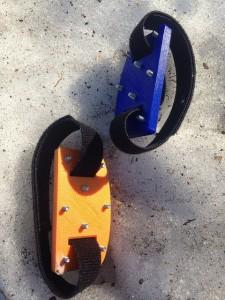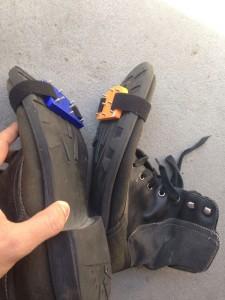As the Central States and the Northeastearn United States continue to be blanketed with snow and ice, there was never a more pressing time — and need — for implementing not only public, but personal safety measures. While your municipality takes care of the roads and, hopefully, the more heavily traversed pedestrian thoroughfares, you may have to take matters into your hands — and feet — when it comes to personal safety closer to home.
matters into your hands — and feet — when it comes to personal safety closer to home.
Thanks to Instructables contributor and Connecticut resident Carmelito Andrade you can make navigating treacherous outdoor surfaces at lot less risky when you 3D print and construct your own DIY Traction Spikes. Designed to adjust quickly, easily and securely to any shoe, Andrade’s Traction Spikes may need to be added to the top of your 3D printing to-do list if you’re in one of the snowy and/or icy states!
The list of supplies you’ll need to complete this project is pretty minimal, which also means the Traction Spikes are super budget-friendly. Even if you don’t have a 3D printer of your own, you can order the printed parts from one of the online 3D printing services like Shapeways, Pinshape, i.materialise, or Sculpteo. On that note, do a quick search and some perusing to see which service is right for you; there are more of them than ever these days, so find the one that best suits your needs.
Your maker list should include the following:
- 3D printer filament; Andrade used orange and blue 1.74 mm PLA
- A laptop on which you’ll download the STL file (you’ll upload to a 3D printing service if you don’t have a printer)

- About 20 32 x ½” screws and, of course, a screwdriver
- Pliers
- Velcro strapping; the width should be 1.4 to 2 cm
Andrade uses PrintrBot Simple Metal. You’ll be slicing the STL file, which will take about two or three minutes. The overall print time for each 3D printed plates for the Traction Spikes will be 20 to 25 minutes.
Once printed and cooled, you’ll use the pliers to hold the plates as you add the screws, which are the “spikes” that keep you from spinning out. Andrade suggests that you experiment with the length of the screws. If you don’t expect to see solid ground beneath the layers of ice and snow before April, you may want to go with longer screws.
I give an enthusiastic “thumbs up” to this pretty easy and straightforward but extremely practical project and suggest you share the love, making several pairs of Andrade’s Traction Spikes for friends and family members — and maybe the mail carrier and the pizza delivery guy!
Let us know if this a project you might undertake this winter over in the 3D Printed Traction Spikes forum thread at 3DPB.com. Check out a video below of the spikes being tested out.

Subscribe to Our Email Newsletter
Stay up-to-date on all the latest news from the 3D printing industry and receive information and offers from third party vendors.
You May Also Like
Profiling a Construction 3D Printing Pioneer: US Army Corps of Engineers’ Megan Kreiger
The world of construction 3D printing is still so new that the true experts can probably be counted on two hands. Among them is Megan Kreiger, Portfolio Manager of Additive...
US Army Corps of Engineers Taps Lincoln Electric & Eaton for Largest 3D Printed US Civil Works Part
The Soo Locks sit on the US-Canadian border, enabling maritime travel between Lake Superior and Lake Huron, from which ships can reach the rest of the Great Lakes. Crafts carrying...
Construction 3D Printing CEO Reflects on Being Female in Construction
Natalie Wadley, CEO of ChangeMaker3D, could hear the words of her daughter sitting next to her resounding in her head. “Mum, MUM, you’ve won!” Wadley had just won the prestigious...
1Print to Commercialize 3D Printed Coastal Resilience Solutions
1Print, a company that specializes in deploying additive construction (AC) for infrastructure projects, has entered an agreement with the University of Miami (UM) to accelerate commercialization of the SEAHIVE shoreline...






























